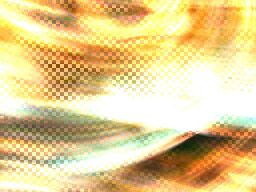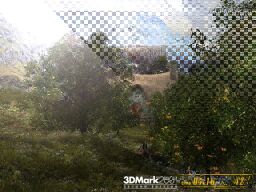| THE SOFTWARE WIZARDS TAKE OVER... |
The next development in the saga came a couple of days later when Guru of 3D reported that Alexey Nicolaychuk, a.k.a. "Unwinder", author of the popular NVidia tweak utility Riva Tuner, had accomplished the 9500-to-9700 transition in software. Naturally, eager 9500 owners wanted to get their hands on the script he used to accomplish this feat, but Alexey announced that they would have to wait a while for his next release of Riva Tuner, which would contain the script known as "SoftR9700". And while you can't fault him for wanting to thoroughly test the script and integrate it into his utility, neither can you blame the masses for wanting to get their hands on the script immediately and try it out!
But Unwinder wasn't the only software guru working on the challenge, it turned out. Within another day or two, the aptly named "W1zzard" over at the HardOCP video forum announced that he had successfully modified a file present in the ATI Catalyst drivers, causing them to run the 9500 card like a 9700, with all 8 pixel pipelines enabled. He posted several versions of the hacked file (HERE), corresponding to various versions of the Catalyst drivers, and users quickly began downloading and testing them. They worked! The reports of successful card mods began flooding in, supported with 3DMark2001 SE fill-rate test results that nearly doubled vs. the stock card. Posting threads at Guru3D, HardOCP, and Rage3D expanded to ungodly lengths as users shared their results and experience. In short order, the new release of Riva Tuner (RC 12.1) was also posted at Guru3D, incorporating the promised "SoftR9700" modification script. It turned out that this script modified the same Catalyst driver file that W1zzard had hacked, so the two approaches were actually accomplishing the same thing. And the SoftR9700 script had the advantage of working on any recent Catalyst driver set, so it wasn't necessary to download a specific file for each Catalyst driver. The initial release of an XP/Win2k-only version was quickly followed by another that handled Win9x.
But all was not joy in Mudville....
| THE FLY IN THE OINTMENT... |
|
The good news was that this stuff WORKED--first with the hardware mod, and later with the software hack, user's Radeon 9500 non-Pro cards were indeed running at 9700 speeds and faster, when overclocked. But not everyone was happy with what they SAW. Unfortunately, some percentage of the modified cards were producing visual artifacts or defects that ranged from occasional and slight to widespread and severe. Most commonly described was an effect referred to as "checkerboarding", typified by the screenshots shown at right.
Other visual defects were also described by various card owners, but this was the most common issue, by far. The percentage of cards that showed the problem was difficult to assess, based upon the reports flooding in to the various forums, but it was definitely very significant--perhaps a third to half of the 9500's were giving the artifacts, when modified. It seemed that the success rate was higher with the software route than with actually modifying the hardware, but there were no actual numbers available to confirm this.
A variety of theories were offered to explain the visual defects, though they were all pretty much conjecture. Probably the most prevalent and plausible was that the defects arose from GPU's that had been "binned" for containing bad pixel pipelines. The supposition was that, when turned back on by the modification, the bad pipelines were producing visual defects. Numerous other theories were put forth, but none seemed to hold up on close scrutiny, or failed to explain some of the observations. Unless ATI steps in and provides a technical explanation, the actual cause may never be known with certainty.
So what's the upshot of this? Well, here in January 2003, there's no doubt that you can buy a Radeon 9500 non-Pro card for under $160 in the US and easily modify the Catalyst drivers to get 9700 performance from it. You may even be able to overclock the core and memory speeds to or above 9700 Pro levels, though this may require flashing the card's BIOS to enable changing the clock frequencies. But there is no doubt that you will be taking a significant RISK of getting a card that won't modify without giving visual defects. Now, that may be a perfectly acceptable risk for some people, particularly if they would be perfectly happy with the 9500 in stock form, should the defects occur. Overall, the card performs about on a par with the Geforce4 Ti4200--better under some circumstances and worse under others, as we'll see in a bit. So it's a very respectable performer, and has the addded incentive of being fully DirectX 9 compliant.
| WHAT IT DOESN'T WORK ON... |
The question comes up constantly about "Does this modification work for ______??", so let's fill in the blank several popular ways:
The 64MB version of the 9500? - Well, yes, but you won't get 9700 performance, because this card lacks the 256-bit memory interface that the 128MB card has. So you basically end up with a 64MB version of a 9500 Pro, since the mod will still turn on the extra 4 pixel pipelines. But definitely worth doing, if not quite as dramatic in final effect.
The 9500 Pro? - Unfortunately, no. The Pro version already has the full 8 pipelines enabled, so doing the mod accomplishes nothing. The issue with the Pro is that it only has a 128-bit memory bus, a physical limitation of the board itself. Sorry!
Other Radeon models? - Nope, sorry. The hardware is completely different. Don't even try.
Now, with the above as history and background, let's get to the most interesting part of the 9500-to-9700 transition: actually doing it!!
 |
 |

